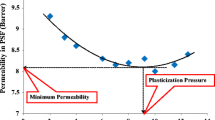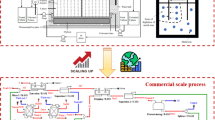Abstract
A modelling and simulation study with economic evaluation was carried out for an advanced membrane-integrated hybrid treatment process that ensures reuse of water with recovery of ammoniacal nitrogen as struvite from coke-oven wastewater. Linearized transport model was developed based on extended Nernst-Plank and concentration polarization modulus equation. Effects of pH, transmembrane pressure and cross-flow rate of interest on membrane charge density, solute rejection and solvent flux were investigated. The membrane module was successful in yielding a pure water flux as high as 120 L m−2 h−1 removing more than 95 and 96 % of the cyanide and phenol, respectively, while permeating more than 90 % NH4 +-N at a transmembrane pressure of only 15 × 102 KPa and at a pH of 10 for a volumetric cross-flow rate of 800 L h−1. The Fenton’s reagents were used to degrade more than 99 % of pollutants present in the concentrated stream. The developed model could successfully predict the plant performance as reflected in the very low relative error (0.01–0.12) and overall high correlation coefficient (R 2 > 0.96). Economic analysis indicated that such a membrane-integrated hybrid system could be quite promising in coke wastewater treatment at low cost i.e. $0.934/m2 of wastewater.








Similar content being viewed by others
Abbreviations
- c m,i :
-
Concentration in membrane of ion i (mol m−3)
- c m,i av :
-
Average concentration of ion i (mol m−3)
- C p,i :
-
Concentration in permeate of ion i (mol m−3)
- C f,i :
-
Feed concentration of ion i (mol m−3)
- D s,i :
-
Hindered diffusivity of ion i (m2 s−1) (D s,i = D B,i × K d,i)
- D B,i :
-
Bulk diffusivity of ion i (m2 s−1)
- d :
-
Thickness of oriented solvent layer (m)
- F:
-
Faraday constant
- J s,i :
-
Ion flux (mol m−2 s−1)
- J v :
-
Volumetric flux (m3 m−2 s−1)
- K c,i :
-
Hindrance factor for convection of ion i
- K d,i :
-
Hindrance factor for diffusion of ion i
- k :
-
Boltzmann constant, 1.38066 × 10−23 J K−1
- ∆P :
-
Applied pressure difference (KPa)
- ∆P T :
-
Effective pressure difference (Kpa)
- P ei :
-
Peclet number of ion i, dimensionless
- R j,i :
-
Rejection (%) of ion i
- r p :
-
Effective pore radius (nm)
- r s,i :
-
Solute radius of ion i (nm)
- R :
-
Universal gas constant (J mol−1 K−1)
- T :
-
Absolute temperature (K)
- ∆x m :
-
Effective membrane thickness (m)
- X d :
-
Effective charge membrane density (mol m−3)
- z i :
-
Valence of ion i
- η ws :
-
Dynamic viscosity of the wastewater (kg m−1 s−1)
- Φ i :
-
Steric coefficient of ion i
- λ i :
-
Ratio of solute radius to pore radius of ion i
- ∆Ψ s :
-
Donnan potential difference (V)
References
APHA (1998) Standard methods for the examination of water and wastewater, 20th edn. American Public Health Association, Washington
Banerjee G (1996) Phenol and thiocyanate based wastewater treatment in RBC reactor. J Environ Eng ASCE 122:941–948
Bodalo A, Gomez E, Hidalgo AM, Gomez M, Murcia MD, Lopez I (2009) Nanofiltration membranes to reduce phenol concentration in wastewater. Desalination 245:680–686
Bowen WR, Welfoot JS (2002) Modeling the performance of membrane nanofiltration- critical assessment and model development. Chem Eng Sci 57:1121–1137
Brond S, Sund C (1994) Biological removal of nitrogen in toxic industrial effluents, high in ammonia. Water Sci Technol 29(9):231–240
Bruggen VD, Everaert D, Wilms D, Vandecasteele C (2001) Application of nanofiltration for removal of pesticides, nitrate and hardness from groundwater: rejection properties and economic evaluation. J Membr Sci 193(2):239–248
Chakrabortty S, Roy M, Pal P (2013) Removal of fluoride from contaminated groundwater by cross flow nanofiltration: transport modeling and economic evaluation. Desalination 313:115–124
Chakrabortty S, Sen M, Pal P (2014) Arsenic removal from contaminated groundwater by membrane-integrated hybrid plant: optimization and control using visual basic platform. Environ Sci Pollut Res 21:3840–3857
El Diwani G, El Rafie S, El Ibiari NN, El-Aila HI (2007) Recovery of ammonia nitrogen from industrial wastewater treatment as struvite slow releasing fertilizer. Desalination 214:200–214
Ferry JD (1936) Ultrafilter membranes and ultrafiltration. Chem Rev 18:373–455
Ghose MK (2002) Complete physico-chemical treatment for coke plant effluents. Water Res 36:1127–1134
Gujer W, Henze M (1991) Activated sludge modeling and simulation. Water Sci Technol 23(4–6):1011–1023
Han B, Shen Z, Wickramasinghe SR (2005) Cyanide removal from industrial wastewaters using gas membranes. J Membr Sci 257:171–181
Kumar R, Pal P (2012) Response surface-optimized Fenton’s pre-treatment for chemical precipitation of struvite and recycling of water through downstream nanofiltration. Chem Eng J 210:33–44
Kumar R, Pal P (2013a) Removal of phenol from coke-oven wastewater by cross-flow nanofiltration membranes. Water Environ Res 85(5):447–455
Kumar R, Pal P (2013b) Turning hazardous waste into value-added products: production and characterization of struvite from ammoniacal waste with new approaches. J Clean Prod 43:59–70
Kumar R, Bhakta P, Chakraborty S, Pal P (2011) Separating cyanide from coke wastewater by cross flow nanofiltration. Sep Sci Technol 46:2119–2127
Marsden J, House I (1992) The chemistry of gold extraction. Ellis Horwood, New York
Minhalma M, de Pinho MN (2002) Development of nanofiltration/steam stripping for the treatment of coke plant ammoniacal wastewaters. Desalination 149:95–100
Mutamim NSA, Noor ZZ, Hasan MA, Olsson G (2012) Application of membrane bioreactor technology in treating high strength industrial wastewater: a performance review. Desalination 305:1–11
Pal P, Kumar R (2014) Treatment of coke-wastewater: a critical review for developing sustainable management strategies. Sep Purif Rev 43(2):89–123
Pal P, Chakrabortty S, Roy M (2012) Arsenic separation by a membrane-integrated hybrid treatment system: modeling, simulation and techno-economic evaluation. Sep Sci Technol 47:1091–1101
Pal P, Kumar R, Srivastava N, Chowdhury J (2014) A visual basic simulation software tool for performance analysis of a membrane-based advanced water treatment plant. Environ Sci Pollut Res 21:1833–1849
Roy M, Chakraborty S (2014) Developing a sustainable water resource management strategy for a fluoride-affected area: a contingent valuation approach. Clean Technol Environ Policy 16:341–349
Santos A, Yustos P, Rodriguez S, Simon E, Garcia-Ochoa F (2007) Abatement of phenolic mixtures by catalytic wet oxidation enhanced by Fenton’s pre-treatment: effect of H2O2 dosages and temperature. J Hazard Mater 146:595–601
Schafer AI, Nghiem DI, Waite TD (2003) Removal of natural hormone estrone from aqueous solutions using nanofiltration and reverse osmosis. Environ Sci Technol 37:182–188
Sen M, Manna A, Pal P (2010) Removal of arsenic from contaminated groundwater by membrane-integrated hybrid treatment system. J Membr Sci 354:108–113
Strathmann H (1992) Electrodialysis. In: Ho WS, Sirkar KK (eds) Membrane handbook. Van Nostrand Reinhold, New York, pp 218–262
Acknowledgments
Authors are thankful to the Department of Science and Technology, Government of India for financial support under Start-up research grant for young scientist (SERB) (SB/FTB/ETA-59/2013).
Author information
Authors and Affiliations
Corresponding author
Additional information
Responsible editor: Bingcai Pan
Rights and permissions
About this article
Cite this article
Kumar, R., Chakrabortty, S. & Pal, P. Membrane-integrated physico-chemical treatment of coke-oven wastewater: transport modelling and economic evaluation. Environ Sci Pollut Res 22, 6010–6023 (2015). https://doi.org/10.1007/s11356-014-3787-6
Received:
Accepted:
Published:
Issue Date:
DOI: https://doi.org/10.1007/s11356-014-3787-6




